Case Study (One) Where it all started
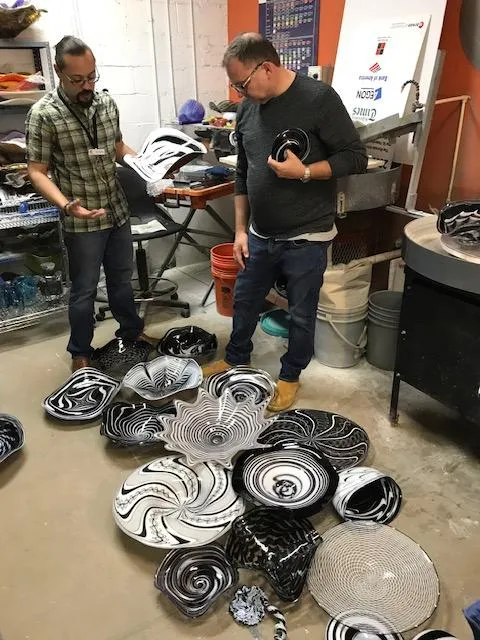
"Genesis of a Vision: The Journey Begins with 'One'"
It all started with a spark of inspiration in St. Pete. There I was, meeting with Matt P, brainstorming for a unique piece for a discerning client's new condo. We were surrounded by a diverse collection of art, each piece a story in itself. As we arranged these works on the floor, a realization dawned on me. To truly create something exceptional, I needed to see beyond the fragments, to envision the complete tapestry.
'One' was the catalyst. This artwork marked the beginning of an extraordinary odyssey spanning five years, a quest to explore and master the interplay of light, glass, and shadow. It was more than just an art piece; it was a revelation, a guiding light leading me into uncharted realms of creativity. In the intricate dance of light and glass, shadows whispered ancient tales, and I listened, learning, growing, evolving.
This journey wasn't just about creating art; it was about redefining it, pushing boundaries, and discovering new horizons within myself. 'One' was not just a beginning. It was a promise of the wonders that lay ahead, a testament to the power of vision and the endless possibilities of Light, Glass, and Shadow Art."
"Whispers of the Canvas: A Dialogue with Light and Space"
Before me stood a two-story blank canvas, vast and inviting, its silent expanse speaking volumes. As I gazed upon this grand space, considering its angles and dimensions, I felt an overwhelming sense of potential. It was as if the walls themselves were conversing with me, urging me to imprint my vision upon their bare surfaces.
The daylight, streaming in through windows and skylights, seemed to have a voice of its own. It whispered, “Include me in your creation.” The sun's rays danced across the emptiness, painting temporary masterpieces of light and shadow. This interplay between the natural light and the architectural canvas was mesmerizing, a beautiful ballet that changed with each passing hour.
In this moment, I realized that my artwork would not just inhabit this space—it would be a living part of it, changing and evolving with the sun's journey across the sky. The room wasn't just a backdrop for my art; it was a critical participant, its unique characteristics influencing and shaping the final piece.
This was more than a project; it was a collaboration with the elements themselves. The blank canvas was not empty but full of whispered possibilities, waiting for me to bring them to life in a symphony of light, glass, and shadow.
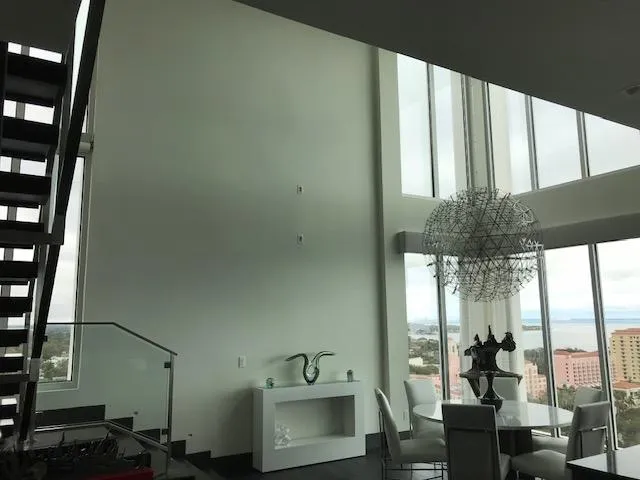
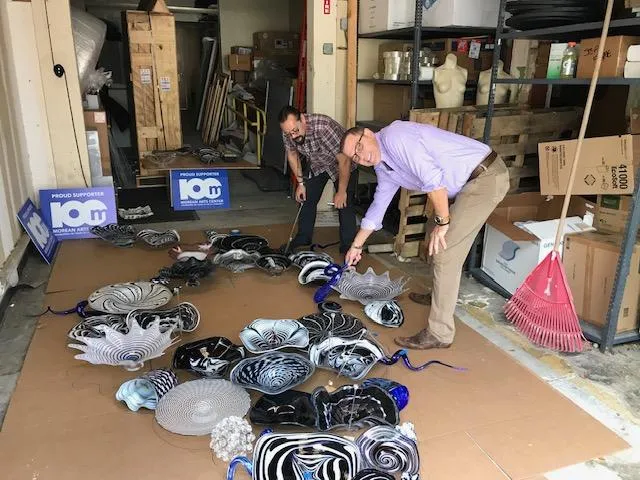
"Shaping the Vision: A Collaborative Masterpiece in Glass"
The journey of creation led us to an empty warehouse, a space that soon became a crucible of artistic endeavor. Our mission was clear: to gather an array of glass pieces, each unique in Black and White color, shape, and texture. These fragments of glass were not just materials; they were the alphabet of a visual language we were about to compose.
In the heart of the warehouse, a large paper template lay taped to the ground, its outlines marking the approximate dimensions of our envisioned masterpiece. Notably, the center remained conspicuously empty—a reserved space for something extraordinary, a centerpiece that would be the soul of our creation.
As we assembled the glass pieces around this void, a mosaic began to form. Each shard, each sliver of glass was a note in an emerging symphony. The diversity of the pieces reflected the myriad possibilities of light and shadow, waiting to be harnessed into a cohesive whole.
The culmination of this phase was marked by an exciting collaboration. We invited the client, the patron of this artistic venture, to join us in the warehouse. This was not a mere presentation; it was an invitation to engage, to be a part of the creative process. Together, we delved into the selection of glass, each choice a step closer to realizing the vision.
The final touch, the selection of the central piece, was a moment of shared anticipation and excitement. It was a testament to the power of collaboration, where artist, material, and patron come together in a celebration of creativity. This was not just an art project; it was a journey of discovery, a shared adventure in the realm of Light, Glass, and Shadow Art.
"Blueprints of Brilliance: Crafting the Glass Mosaic"
With our collected trove of glass pieces, each carefully chosen for its unique beauty, we embarked on the next crucial phase of our artistic journey. The paper template, a silent witness to our creative deliberations, was now ready to transform into the blueprint of our envisioned masterpiece.
We began by meticulously tracing the outline of each selected glass piece onto the paper template. This process was akin to capturing shadows, immortalizing each fragment's shape and size, ensuring that its role in the final composition was precisely defined. As we traced, the paper slowly metamorphosed into a complex map, a guide to the intricate mosaic we were about to assemble.
Each piece of glass was then assigned a number, a small but significant act that brought order to the kaleidoscope of shapes and colors before us. This numbering was not just a practical step; it was a nod to the harmony we sought to achieve, where each piece, no matter how small or seemingly inconsequential, had its place and significance.
Finally, with a mixture of anticipation and reverence, we cut the paper template. Each incision was a commitment, a physical manifestation of the decisions made during our collaborative selection process. Cutting the template symbolized the transition from planning to execution, from a vision held in our minds to a tangible, physical creation.
This act was more than mere preparation; it was a ritual, marking the beginning of the actual assembly of the glass mosaic. The numbered pieces, each with its destined place, were ready to come together, not just as a collection of individual fragments, but as a cohesive, breathtaking work of art, born from the union of light, glass, and shadow.
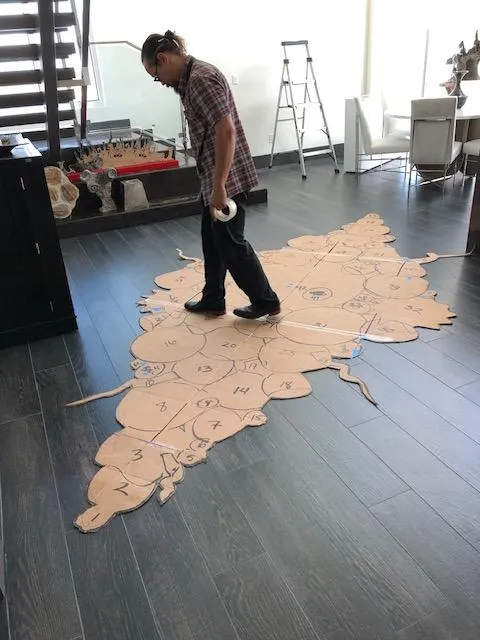
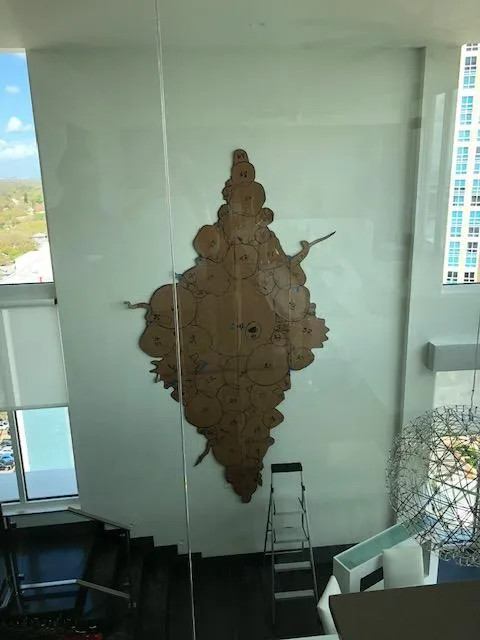
"Visualizing the Masterpiece: Mounting the Template"
The next step in our artistic journey involved bringing our vision closer to reality. With the paper template, now intricately traced and numbered, in hand, we prepared to bridge the gap between conception and realization. Our aim was to ensure that the envisioned glass mosaic harmonized perfectly with its destined environment.
We carefully mounted the paper template on the wall, the very wall that would soon hold our completed work of art. This was a critical moment, a fusion of planning and space. The template, once flat and lifeless on the ground, came to life as it adhered to the wall. It stood as a life-sized representation of our vision, a ghostly precursor to the vibrant glass mosaic to come.
Mounting the template was not just a practical step; it was a moment of validation. It allowed us to see, perhaps for the first time, how the proportions of our artwork would interact with the wall space and the surrounding area. This visual representation was vital in ensuring that our creation would not only fit its physical location but also complement and enhance the space around it.
As we stepped back to view the template in its new position, we could see the potential interplay of light and shadow, the way the artwork would engage with the changing sunlight through the day. This process was an affirmation of our artistic choices, a confirmation that our vision was in harmony with the space it was destined to occupy. It was a moment of anticipation, a glimpse into the future where our creation would not just occupy a space on a wall, but transform it entirely.
"Engineering Art: Constructing the Sculpture's Backbone"
Returning to our studio, we embarked on a crucial phase of construction that would give our glass mosaic not just form, but also strength and stability. The focus was now on building the sculpture's backbone, a task that required both artistic vision and engineering precision.
The backbone was to be made of reinforced steel, chosen for its durability and ability to support the intricate and heavy glass pieces. This steel structure was more than just a frame; it was the skeleton that would hold our artistic creation together, a testament to the fusion of art and structural design.
Crafting the steel backbone demanded meticulous attention to detail. Each bend, each weld, was performed with the final shape of the mosaic in mind. This process was a delicate balancing act, ensuring that the structure was strong enough to support the glass, yet subtle enough to not overshadow the art itself.
An additional challenge was the practicality of transportation. The final destination of our masterpiece was a penthouse, which meant that each component of the sculpture, including the steel backbone, had to be designed to fit within the confines of an elevator. This constraint added an extra layer of complexity to our design process, as we had to ensure that the sculpture could be disassembled into transportable sections without compromising its structural integrity or artistic coherence.
This stage of the process was a dance between the artistic and the practical, a reminder that creating art is not just about aesthetics, but also about overcoming physical and logistical challenges. Each cut of the steel, each assembled section, brought us closer to realizing our vision, a vision that was slowly but surely taking on a tangible, majestic form.
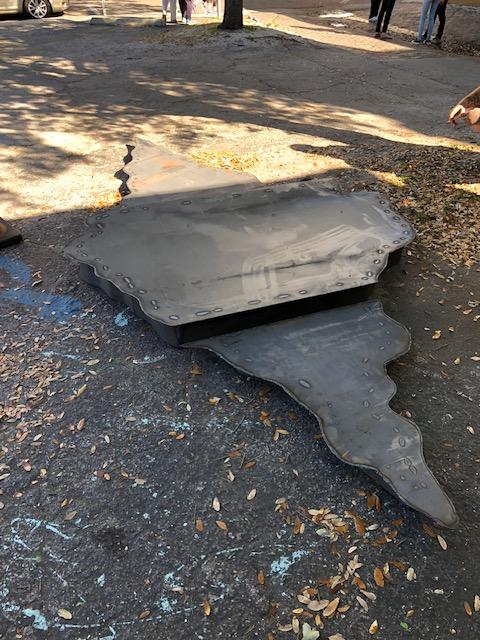
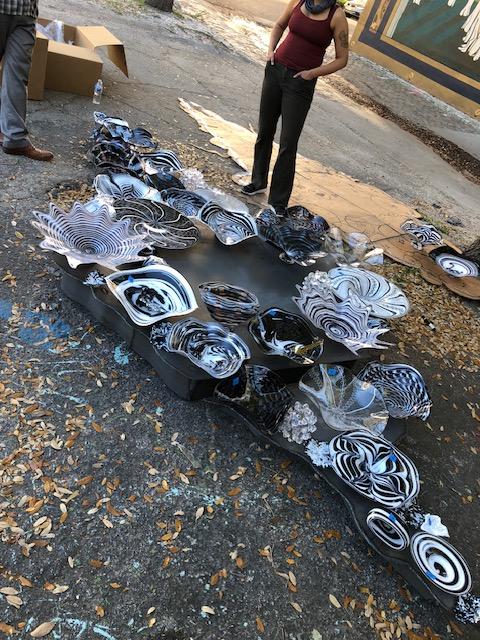
"Precision and Harmony: Aligning Glass and Frame"
With the reinforced steel backbone meticulously crafted and ready, it was time to embark on a critical and delicate stage of our artistic process: aligning and placing the glass pieces onto the frame. This step was not just about aesthetics; it was a complex ballet of precision and engineering, ensuring that each piece of glass would be perfectly positioned and securely mounted.
We began by methodically testing each glass piece on the frame, a process akin to solving a three-dimensional puzzle. Each shard, each fragment of glass, had its unique place, a specific spot where it would contribute to the overall harmony of the sculpture. This was a slow, methodical process, requiring patience and an eye for detail.
As we placed each piece of glass onto the frame, we carefully marked the locations where the brackets would be mounted. These brackets were crucial, as they would hold the glass securely in place, ensuring both the safety and longevity of the sculpture. Each mark was a commitment, a decision that shaped how the piece would interact with light and shadow, how it would be perceived from different angles.
This process was a delicate balance between the physical properties of the glass and the aesthetic vision we were striving to achieve. We had to consider the weight distribution, the way light would pass through each piece, and how the colors and textures would come together in a cohesive whole.
As each piece found its place and each bracket was marked, the sculpture began to reveal its true form. This was a moment of transformation, where individual pieces of glass, once separate and distinct, came together to form a larger, more beautiful entity. It was a testament to the power of careful planning, precise execution, and the harmonious union of art and engineering.
"Final Stages: Perfecting Each Section Before LED and Paint"
In the final stages of our project, before the integration of LED lights and the application of paint, our focus was on perfecting each of the three sections of the sculpture. This crucial phase was about ensuring that every element was meticulously refined and harmonized, laying a flawless foundation for the subsequent steps.
The process began with a thorough examination of each section.
We paid close attention to the placement and alignment of the glass pieces, ensuring that they were positioned exactly as planned. This involved checking for any gaps or inconsistencies in the layout, and making necessary adjustments to achieve the perfect composition.
We also focused on the structural integrity and aesthetics of the steel frame. It was essential to ensure that the frame was not only strong and capable of supporting the glass pieces but also visually appealing and in line with our artistic vision. We examined every joint, weld, and curve, making sure that the frame complemented the glass elements without overpowering them.
This stage was also about preparing the surfaces for the next steps. We ensured that the glass and steel were clean, free of any dust or debris, and ready for the application of LED lights and paint. This preparation was vital to achieve a seamless and high-quality finish in the later stages.
The careful attention to detail in perfecting each section set the stage for the dramatic transformation that would follow with the addition of lighting and paint. It was a testament to our commitment to quality and precision, ensuring that the foundational elements of our artwork were flawlessly executed before adding the final, transformative touches.
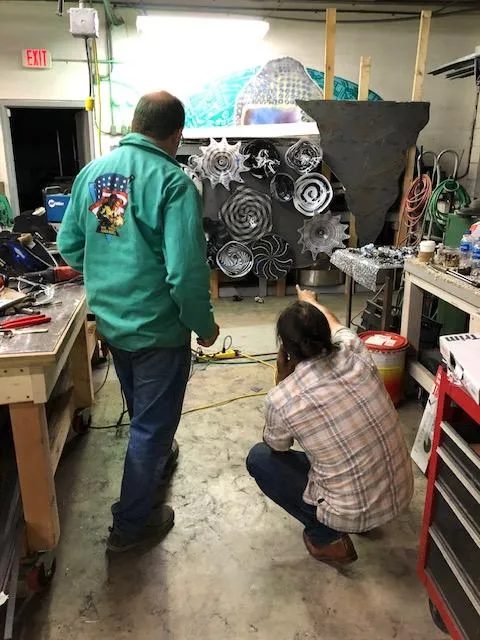
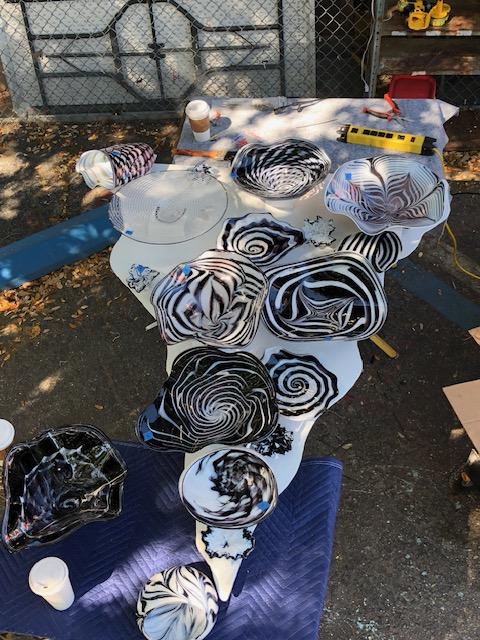
"Illuminating the Artwork: Integrating LED Lights"
Following the application of the primer paint coat, a crucial and transformative phase of our project commenced: the integration of LED lights into the artwork. This stage was not just about illumination; it was about bringing a dynamic and vibrant energy to the sculpture.
The task at hand was significant - we were to position approximately 300 LED lights, each carefully selected for its color, intensity, and effect. This process was akin to composing a symphony with light, where each LED played a note, contributing to a harmonious and mesmerizing visual melody.
Strategically placing these lights required a deep understanding of how light interacts with glass. We considered factors like the refraction and reflection of light, the way different colors of light would enhance or alter the hues of the glass, and how shadows would add depth and dimension to the sculpture.
Each LED light was positioned to accentuate the unique qualities of the glass pieces, to highlight their textures, and to create an interplay of light and shadow that would change and evolve throughout the day and night. This careful placement was essential to ensure that the sculpture would not only be visually stunning but also engaging from every angle.
The integration of LED lights transformed the sculpture into a living entity, a dynamic artwork that responded to its environment. It was a bold statement in the art of combining traditional materials like glass and steel with modern lighting technology, creating a piece that was not only a feast for the eyes but also an exploration of the possibilities of contemporary art.
"Birth of a Concept: The Glass Explosion in the Centerpiece"
During the intricate process of assembling the central element of our sculpture, a moment of creative inspiration struck, giving birth to a captivating concept: envisioning a glass explosion piercing through the heart of the centerpiece. This idea was not just an addition to our design; it was a vivid, dynamic expression that would transform the entire artwork.
The concept of a glass explosion conjured images of dynamic movement, of shards of glass seemingly caught in a frozen moment of energy and force. This imagery was both powerful and delicate, a paradoxical blend of strength and fragility that perfectly encapsulated the essence of working with glass.
Implementing this idea required a blend of artistic vision and technical skill. We envisaged pieces of glass radiating outwards from the center, each shard meticulously placed to create the illusion of an explosive force emanating from within. The selection of these pieces was crucial – varying in size, color, and texture, they needed to convey a sense of motion and impact.
As we integrated this glass explosion into the central element, the sculpture began to take on a new dimension. It was no longer just a collection of carefully arranged glass pieces; it had become a dynamic scene, capturing a moment of beautiful chaos, frozen in time and space.
This artistic decision enriched the narrative of the sculpture, adding a layer of complexity and intrigue. It invited viewers to not only appreciate the beauty of the materials and the craftsmanship but also to engage with the artwork on a deeper level, contemplating the power and beauty inherent in moments of transformation and upheaval.
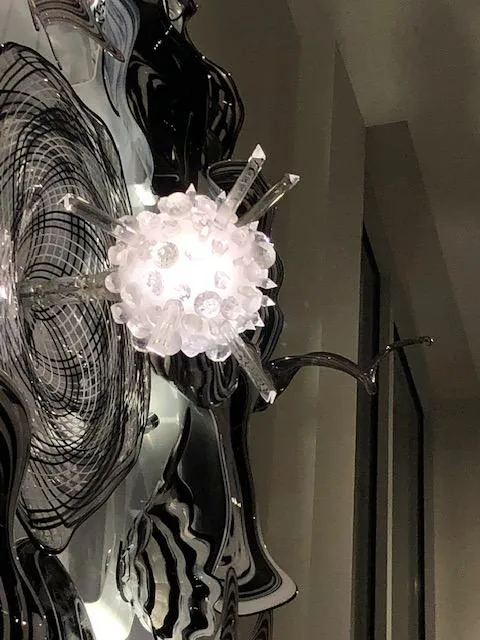
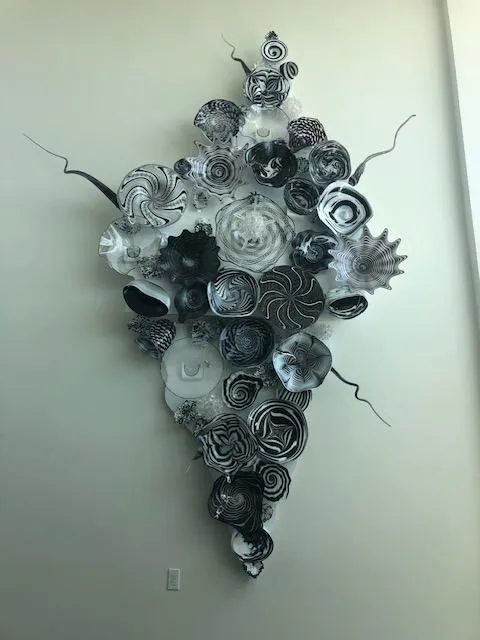
"Realizing the Vision: Daytime Brilliance of the Assembled Masterpiece"
Once the assembly was complete, the final result stood before us, a resplendent embodiment of the vision I had nurtured from the outset. Seeing the sculpture in the full light of day, its every detail and nuance illuminated, was a moment of profound fulfillment.
The daytime brilliance of the artwork brought to life all the elements we had so carefully crafted. The glass explosion at the center, with its dynamic array of shards, sparkled under the sun's rays, casting a kaleidoscope of shadows and reflections. The interplay of light and glass created an ever-changing display, highlighting the depth and complexity of the sculpture.
Each piece of glass, with its unique hue and texture, contributed to a larger mosaic of light and color. The reinforced steel frame, now a subtle but integral part of the whole, provided a sturdy yet elegant structure that enhanced the overall aesthetic.
This was more than just a physical realization of a concept; it was the manifestation of a creative journey, a journey marked by innovation, collaboration, and meticulous craftsmanship. Seeing the sculpture in daylight, exactly as I had envisioned, was a testament to the power of artistic vision and the relentless pursuit of perfection.
The artwork, now complete, stood not only as a stunning visual experience but also as a symbol of what can be achieved when imagination is given form and substance. It was a reminder that art, at its best, is not just seen but experienced, engaging the viewer in a dialogue of light, shadow, and beauty.
"Transformative Nighttime Aura: The Sculpture's Evening Tale"
As night fell, the sculpture underwent a dramatic transformation, unveiling a completely different story under the cloak of darkness. This nocturnal metamorphosis revealed the dual nature of the artwork, showcasing its ability to captivate in entirely distinct ways from day to night.
With the setting of the sun, the LED lights we had intricately integrated into the sculpture came to life. These lights, numbering around 300, bathed the glass pieces in an ethereal glow, creating a stark contrast to the daytime brilliance. The once vibrant colors and reflections now took on a more subdued, yet equally mesmerizing, quality.
The glass explosion at the center became a focal point of light, its shards illuminated from within, casting a gentle, radiating luminescence. This effect created an illusion of depth and movement, as if the explosion were alive, gently pulsing with a light of its own.
The interplay of shadows became more pronounced, adding a layer of mystery and intrigue to the sculpture. Shadows cast by the glass pieces intertwined with the illuminated sections, creating a dance of light and dark that captivated the viewer.
This nighttime persona of the sculpture told a different story, one of calm and introspection. It invited onlookers to explore the depths of the artwork, to see beyond the physical elements and engage with the emotions and narratives evoked by the play of light and shadow.
The transformation of the sculpture at night was a reminder of the dynamic nature of art – how it can change and evolve with time and context, offering new perspectives and experiences. The artwork, in its nighttime guise, stood not just as a visual spectacle but as a living, breathing entity, telling its own unique tale under the stars.
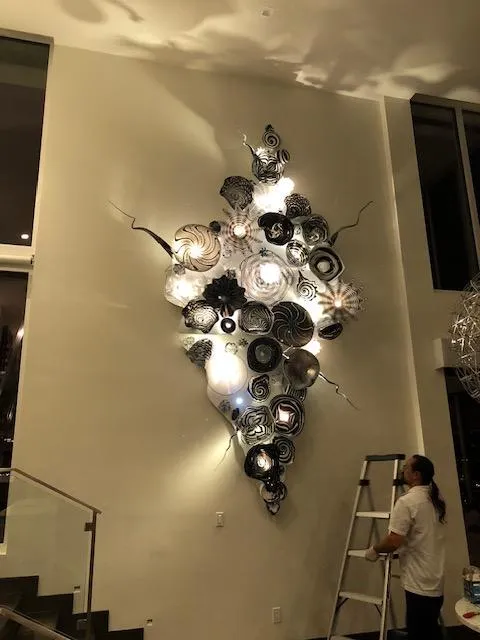
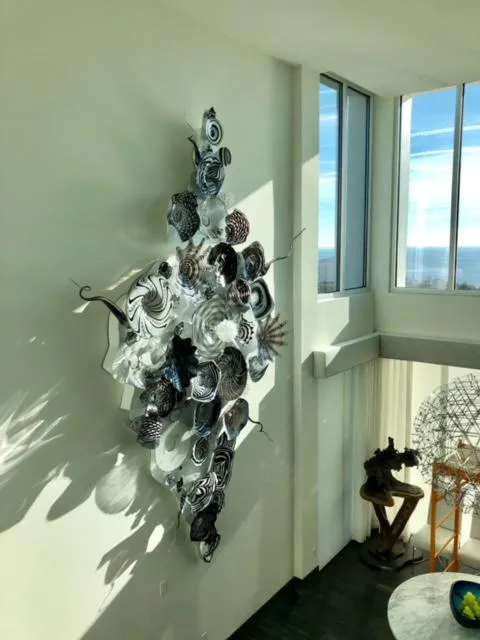
"Sunlight's Contribution: The Sculpture's Dance with Daylight"
In the ever-changing cycle of day and night, the sun played a pivotal role in the life of our sculpture, especially when its rays peaked through. The interaction between the sunlight and the sculpture created a dynamic and ever-evolving display, adding another layer to the artwork's multifaceted narrative.
As the sun moved across the sky, its beams interacted with the glass in a spectacular dance of light. Each ray that peeked through the sculpture illuminated the glass pieces, bringing out vibrant colors and casting intricate patterns of light and shadow around the space. This natural illumination brought an organic and unpredictable element to the artwork, making it feel alive and in constant flux.
The glass explosion at the center of the sculpture, in particular, took on new dimensions under the sun's influence. The sunlight filtering through the shards created a prism-like effect, scattering rainbow hues in all directions. This interaction not only enhanced the visual impact of the piece but also highlighted the meticulous craftsmanship and the thoughtful placement of each glass fragment.
During these moments of peak sunlight, the sculpture was not just an object to be viewed but an experience to be felt. It engaged viewers in a visual conversation, inviting them to appreciate the subtle nuances brought forth by the interplay of natural light and art.
The sun's contribution to the sculpture was a daily reminder of the harmony between art and nature, and how the environment in which art exists can become an integral part of its expression and beauty. This relationship between the sculpture and the sunlight created a living artwork, ever-changing and endlessly fascinating.
"Deepening Gratitude: Recognizing Matt’s Extensive Support"
In reflecting upon the creation of this striking sculpture, a journey through Light, Glass, and Shadow, my gratitude towards Matt deepens. Not only did he entrust me with his client, but he also generously opened up his world to me, providing access to his network of friends, his shop, fabricators, and other glass artists.
Matt's role as a mentor and friend was enriched by this act of trust. He didn't just believe in my vision; he actively supported it by connecting me with a community of skilled individuals and resources. His shop became a sanctuary for experimentation and creation, a place where ideas could take physical form. The fabricators and glass artists he introduced me to were not just collaborators; they were teachers and inspirations, each contributing their expertise to the project.
This access to a wider community of artists and resources was pivotal. It allowed me to explore new techniques, to learn from seasoned professionals, and to integrate a variety of influences and skills into my work. This collaborative environment fostered by Matt was a crucible of creativity, where the sharing of knowledge and experience enriched both the process and the final piece.
The sculpture, now a testament to this shared journey of creation, stands as a symbol of Matt’s unwavering faith in my abilities and his commitment to my artistic growth. His trust and the resources he provided were instrumental in transforming a concept into a reality, a reality that speaks not just of my vision, but of the collective effort and support of an entire artistic community.
For this, my gratitude to Matt is profound. His role transcends that of a mentor and friend; he has been a catalyst for artistic development and a bridge to a community that has immensely enriched both the artwork and my own journey as an artist.

